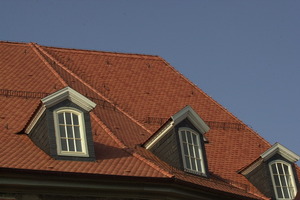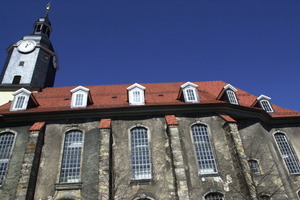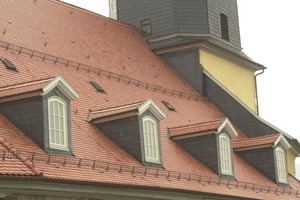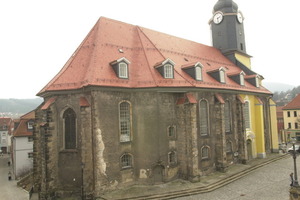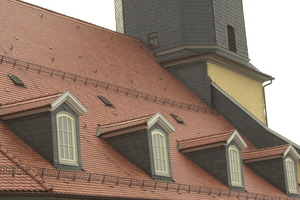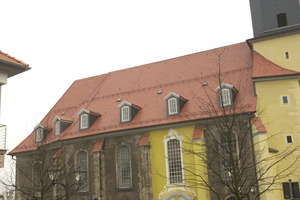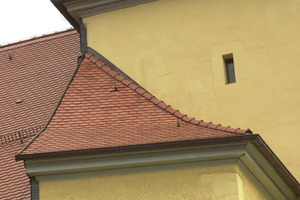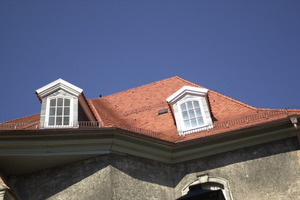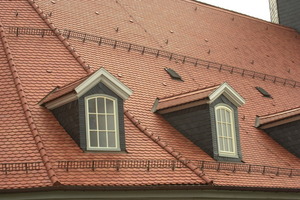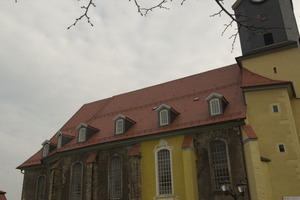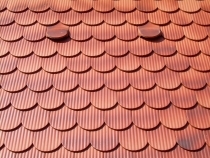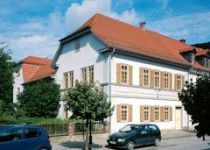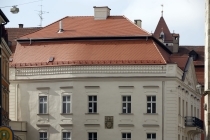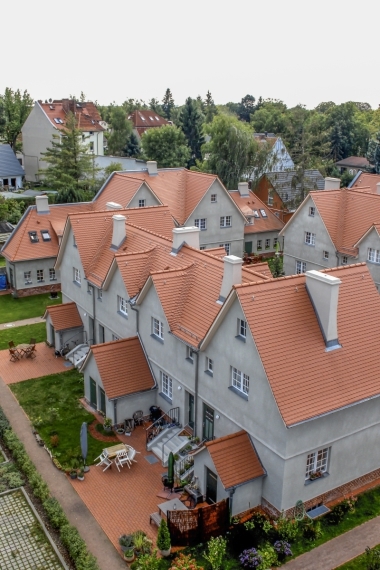Romantik plain tiles now adorning historical Church of St. James in Ilmenau
Especially in times of tight money for towns, countries and authorities, it is nice to see financial efforts being invested to preserve the substance and original appearance of heritage-listed buildings. Case in point: the townscape-defining Church of St. James (St. Jakobus-Kirche) in Ilmenau, Thuringia. With a belfry tower measuring nearly 50 meters high, the structure's dominant characteristics include its baroque exterior, an enormous main roof and a choir roof featuring multiple valleys and hips. The whole roofscape, all 1,300 m² of it, was recently re-covered with Romantik plain tiles from Walther Dachziegel GmbH from the Franconian town of Langenzenn. Now, under the protection of its new clay tile roof, St. James has become a centre of cultural encounter.
Indeed, the church has a very eventful history. Its foundations rest on two Romanic ante-churches from the 12th and 14th centuries, the foundation masonry of which was exposed in connection with the ground-up renovation, and which have since been documented in showcases and drawings. Remnants of walls dating from the 5th century are an unmistakable indication of a Gothic hall church that once stood at the same place but fell prey to a great fire in 1752. According to preliminary designs by G.H. Krohne, architect to the ducal court in Saxony-Weimar, construction of the new Church of St. James began in 1762 under the direction of master builder A.F. Strassburger from Eisenach. The new tower and steeple completed the church in 1769.
All the conjunctural repairs, replacements and reconstructions on tower, steeple, roof structure and covering, not to mention the façades, made it necessary - after Germany's political transition - to comprehensively restore the entire place of worship inside and out. From the very beginning, the monuments office and the fundraising group Förderkreis Stadtkirche Ilmenau pursued the goal of restoration on the basis of the found-and-registered elements of diverse architectural styles, with a clear baroque dominance, of the hall church with its baroque character, as designed by architect Krohne and constructed by master-builder Strassburger. Since 1992, the local architectural and engineering consultant Gert Schaser has been carrying the responsibility for planning and supervising the project activities. Schaser's team has ample experience in - and competence for - the rehabilitation of historical structures. In fact, the architect demonstrated his fondness for heritage buildings in the refurbishment of his own offices and home in a historical colliery building that was built to house the local mining authority in or around 1691. Historians name Johann Wolfgang von Goethe as the baroque structure's most famous visitor. Goethe was a long-time advocate of reviving Ilmenau's once native copper mining activities.
All about the Church of St. James project: The 1st phase of the project, including restoration of the tower and steeple, stairwell and the entire west façade, has already been successfully completed, and the necessary roof rejuvenation was moved ahead of the second phase as preparatory step for the exterior façade. "The roof skin was in worse condition than expected," explains architect Schaser. "Even most of the furring had to be replaced, so the finished job comprises new battening, counter-battening and a sarking membrane that all add up to a healthy, safe, well-functioning roof that will last for decades." Unlike most comparable church buildings, the roof on this one had numerous angle-forming portions, two main-roof elements and two steep sections that all follow the contours of the building itself. Steeply sloping hips alternate with as many valleys, and a "wreath" of twelve dormer windows dating from the time of the church's origin provide daylight for the interior space between the second gallery and the nave.
The issue of tiled-roof authenticity was clarified by way of historical documents and in close consultation with the Thuringian Office for the Preservation of Historical Buildings and Monuments. What tipped the scales in favor of Romantik plain tiles by Walther was their unusual coloration, with shades and hues ranging from natural red to reddish-yellow. Those responsible all agree that "the multifarious colour spectrum of the tiled roof harmonizes with the surrounding, old-established building substance and gives the entire surface a patinated character." The new roofing has also found favor with the townspeople.
Not least for safety reasons, it was decided to use embedded plain-tile valleys, particularly since the sheet metal valleys that had been in use before were leaky. Also, some of the adjoining tiles had been scruffily cut, and the roof structure had suffered moisture damage. While the new valleys extending over the full rafter span of 13 to 16 m actually were something of a headache for the roofers, master roofer Dirk Hopf and his team from nearby Elgersburg had what it took in the way of artisanal diligence and fine touch to reach a "high C" in the art of roofing.
The problem was that each of the four valleys had a different hip inclination. "The trick," Dirk Hopf explains, "was to make sure that no cross joints would result when the last tile from the other side of the roof was embedded. It took quite a bit of fiddling to get all the tiles on the left and right side cut to the proper sizes and shapes. The valleys were secured in the standard manner, i.e., screwed down on a roof slope of 46°. The eight hips with a total length of 116 m were clamped, and the ridge and vent tiles were laid dry. The vertical dormers in the 50°-inclined main roof were also covered with plain tiles, while the dormer cheeks were clad with Thuringian slate. The connections to the main roof were executed using copper valleys and screw-down connecting tiles to keep winter snow from pressing in underneath the tiles.
Master roofer Dirk Hopf, who counts numerous heritage-listed objects among his references, is a specialist for true-to-detail roof restoration and beholden to medieval German roofing tradition - but not at the exclusion of modern technologies. He not only finds the faithfully reconstructed new roofscape on the Church of St. James more than convincing, but also and especially the arrestingly vivacious look of its Romantik plain-tile roofing.
Now that the roof is finished and well-done, the second phase of the project is soon to begin, also under the auspices of architect Gert Schaser. This will cover restoration of the south, north and choir façades with conservation-appropriate stucco structuration and colouring. The people of Ilmenau are very much looking forward to the day when the old house of worship returns to active service as a central place to meet and greet.

